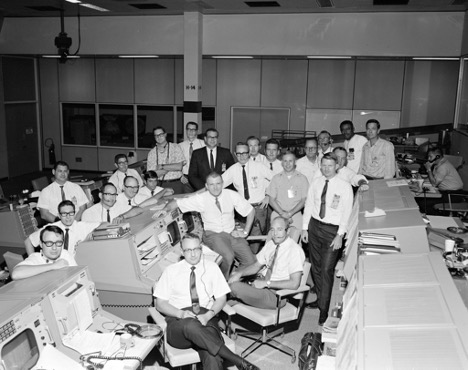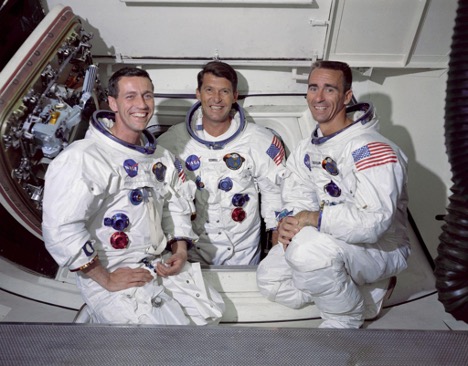Apollo 7 went down in history as the most ambiguous NASA mission that almost ended in mutiny but successfully achieved all of its goals. Apollo 7 launch was the first manned mission after a tragic Apollo 1 accident that made many people doubt the feasibility of the Moon exploration program. So, it’s no wonder that the tensions during Apollo 7 mission were high. Below, we’re listing top Apollo 7 facts that will shed some light on this major space mission.
Where Did Apollo 7 Go?
Apollo 7 mission never implied landing on the Moon, but it had to reach its orbit to carry out tests of the command and service module (CSM). After the tragic death of the Apollo 1 crew, many began to doubt this program’s feasibility, and it was very important to prove to the public and Congress that both modules were reliable, habitable, and safe. Also, the Apollo 7 crew (commander Wally Schirra, service module pilot Donn Eisele, and lunar module pilot Walter Cunningham) had to broadcast almost everything back to Earth, which interfered with their mission goals and caused additional trouble and tensions with Mission Control Center (MCC). But what exactly went wrong with Apollo 7?
What Problems Did Apollo 7 Have?
As often happens with problematic missions, Apollo 7 setbacks began almost at the start. The mission launch was supposed to be postponed due to strong winds that might have interrupted the rocket’s trajectory. However, MCC decided to neglect safety rules and give this launch a go. This decision was one of the first things that caused commander Schirra’s indignation, but sadly, it was not the last.
A few hours into Apollo 7’s launch, Schirra reported catching a cold, which very soon spread to other crew members. Back on Earth, a runny nose may not seem much of a problem, but in space microgravity conditions, mucus cannot simply run down like it would on Earth. Blowing noses, on the other hand, would cause damage to eardrums, so the Apollo crew had to rely on decongestants and aspirin all through their flight.
The cold was also one of the reasons why Apollo astronauts refused to turn on TV broadcast cameras as often as they were supposed to. Schirra categorically objected to doing anything that would interfere with Apollo 7 mission goals. And, according to the Apollo commander, TV broadcasts often interfered.
Another problem encountered during this prominent mission was the lack of the previous testing. By the time CSM was supposed to dock with S-IVB, the Saturn rocket’s second stage, it had become clear that the ship was never equipped with a rendezvous radar. What’s even worse, the SPS engine that was supposed to launch the lunar module into orbit and bring it back, malstarted — fortunately, only during its first launch.
The next issue arose with excessively noisy fans onboard the spacecraft — according to Apollo 7 crew members, this noise was so strong that they eventually decided to turn two fans off. The cockpit quickly fogged up, forming a few puddles. Schirra’s team solved this problem by draining excessive moisture into an outer space with a urine pipe. However, while puddles went away, misty windows, interfering with visibility, remained. One of the possible reasons for misted windows was an issue with window sealant, but as the mission crew admitted later, this mist did not interfere much with observation and photography taking.
One of the last problems occurred because of the cold that troubled the Apollo crew all through this flight. During the ship’s capsule re-entry into our planet’s atmosphere, everyone onboard was supposed to wear protective helmets in case the cabin will get damaged and depressurizes. However, Apollo crew members categorically refused to do this because, in a helmet, they would not be able to blow their mucus-filled noses. By this time, the mission crew and MCC had already exchanged a few sharp words, and this final act of insubordination became the proverbial ‘cherry on top.’
Why was the Apollo Mission Described as a Successful Failure?
Despite all tensions during Apollo 7 flight, the capsule successfully splashed down seven nautical miles north of its expected rendezvous spot with a rescue ship USS Essex. The mission completed all of its goals, and Apollo 7 crew members came back unharmed. Besides, television broadcasts, even though they did not always happen as planned, gave rise to national enthusiasm and restored the public’s faith in the Apollo program’s future.
Still, because of constant tensions with the MCC, none of the Apollo 7 astronauts flew to space again. In fact, Schirra announced his resignation from NASA even before the end of this historic flight, while Eisel and Cunningham fell out of NASA’s favor shortly after. However, their mission, despite all hardships and miscommunications, was a complete success that restored the public’s trust in the program and paved the way for further moon exploration missions — thanks to which we all saw Neil Armstrong make his first steps on the Moon.



